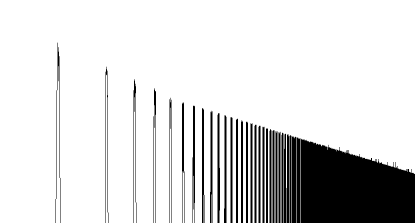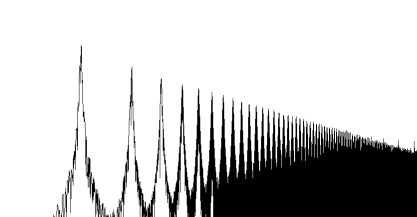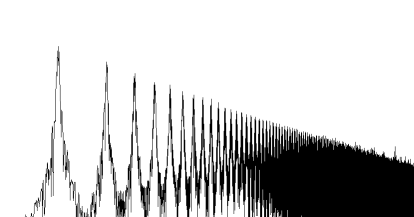
|

|

|

|

|

|

|

|
Sound Modelling - Supersaw
© Ing. Radovan Konečný - radkon, 2012
About the project
The goal of this project was to create interesting and usable sounds using the addition of multiple saw-shape signals and, in addition, to create loops - i.e. so that the end is perfectly tied to the beginning - to make the sound cyclical.
The principle of such sound creation (but not cyclic) has previously appeared in Roland analog synthesizers called Supersaw. At that time, it was realized using 7 (or less or more) saw-shape generators whose frequencies were shifted so that the sound was a little bit similar to the string ensemble. The saw shape was chosen because its sound color is most similar to the sound color of string musical instruments. However, a simple saw-shape waveform has a very simple frequency spectrum and does not imitate a string that produces a richer spectrum. Composition of multiple saw-shape waveform (frequency-shifted) will create a richer spectrum that is much more similar to the string ensemble.
Comparison of saw-shape and Supersaw sound:
(Note: Some sound samples may not work in Internet Explorer.)
- simple saw-shape waveform
- Supersaw (7 generators)
- Supersaw (14 generators)
(These and other sound samples are examples of "raw" sound - without filtering, so they do not good imitate strings ensemble in this form.)
Frequency spectrum of the saw-shape signal:

Frequency spectrum of the Supersaw (7) signal:

This sound is also embedded in my Virtual analog synthesizer - there is a sound made of 7 or 14 saw-shape generators and detuning of the generators can be adjusted (the sidebands can be expanded).
The frequency spacing of the individual saw generators is advantageous to make without regularities which would lead to regular beats of the sound color.
In other words, the moment when all generators reach the point where they already were, should be as late as possible.
Example: two generators make sound, the first has a frequency of 1000 Hz, the second one 1001 Hz.
Beats occur that will be repeated every second (frequency difference 1001 - 1000 = 1 Hz, corresponding to the 1 second period).
For three generators: the first has a frequency of 1000 Hz, the second 1001 Hz, the third 1002 Hz.
Beats occur - one with a period of 1 second (1001 - 1000 = 1 Hz) and the second with a period of 0.5 second (1002 - 1000 = 2 Hz).
However, the signal will be repeated with the period of 1 second (and within 1 second there will be a second beat with the period of 0.5 second).
If the detuning is appropriately chosen (and irregular), a more complex signal will occur, which will be repeated even over a very long time.
In the case of an analog or virtual analog synthesizer, it does not matter that the signal will be repeated for a very long time (and these may be years!), but the goal of this project is to create Supersaw so that the signal repeats after a given time. Then, this sound can be loop-played back and the end will be perfectly tie to the beginning (no disturbing sound will be heard when the transition from the end to the beginning).
Creating Supersaw for KORG M1
The first reason for creating such sounds was the remade KORG M1 synthesizer for which I wanted to create the Supersaw sound samples. An unpleasant limit is the limitation of the sound (loop) length for about 2 seconds. So it was necessary to create a sound composed of a number of saw-shape waveforms, which would be repeated in no more than 2 seconds.
Examples of the Supersaw samples for KORG M1:
(Note: Some sound samples may not work in Internet Explorer.)
- Supersaw (1024 generators) - lower tone
- Supersaw (1024 generators) - higher tone
Frequency spectrum of Supersaw loop for KORG M1:

These samples are perfect loops and have been calculated so that the end is perfectly tied to the beginning. It's neither a coincidence nor an additional Supersaw signal processing, but the calculation itself is designed and made to produce a cyclical sound (loop) of a predetermined length. There are 1024 saw-shape waveform generators used here, and the frequency spectrum is filled with harmonic components of lower amplitude. The frequency spectrum and amplitude of individual generators are suitably designed and is not the same.
- Supersaw (1024 generators) - sound inserted into KORG M1
Creating Supersaw for the sampler
The second use of such sounds (loops) is Sampler. Here, limits of the loop length is not so strict, so some other calculations need to be used, but the principle is the same. So, the lengths of the loops have to be determined so that the sound is perfectly cyclical.
Here I enriched the sound even with the amplitude modulation of each generator by a random signal. This random signal is filtered noise (the cut-off frequency is 5 Hz) and is also cyclical (the end is perfectly tied to the beginning). Sound gives it a more natural character.
Examples of the Supersaw sound for the sampler (not entire loops):
(Note: Some sound samples may not work in Internet Explorer.)
- Supersaw (1024 generators)
- Supersaw (10000 generators)
- comparison of 1024 and 10000 generators (first 1024, then 10000)
Supersaw (1024) spectrum for sampler:

On low tones, the loop length is several minutes. The stereo is made in such a way that the saw generators are distributed alternately between the left and right channels.
Several other sound samples are on the Sampler project page.
A similar project, based on a different algorithm, is Sound modelling - NoiseSaw.


